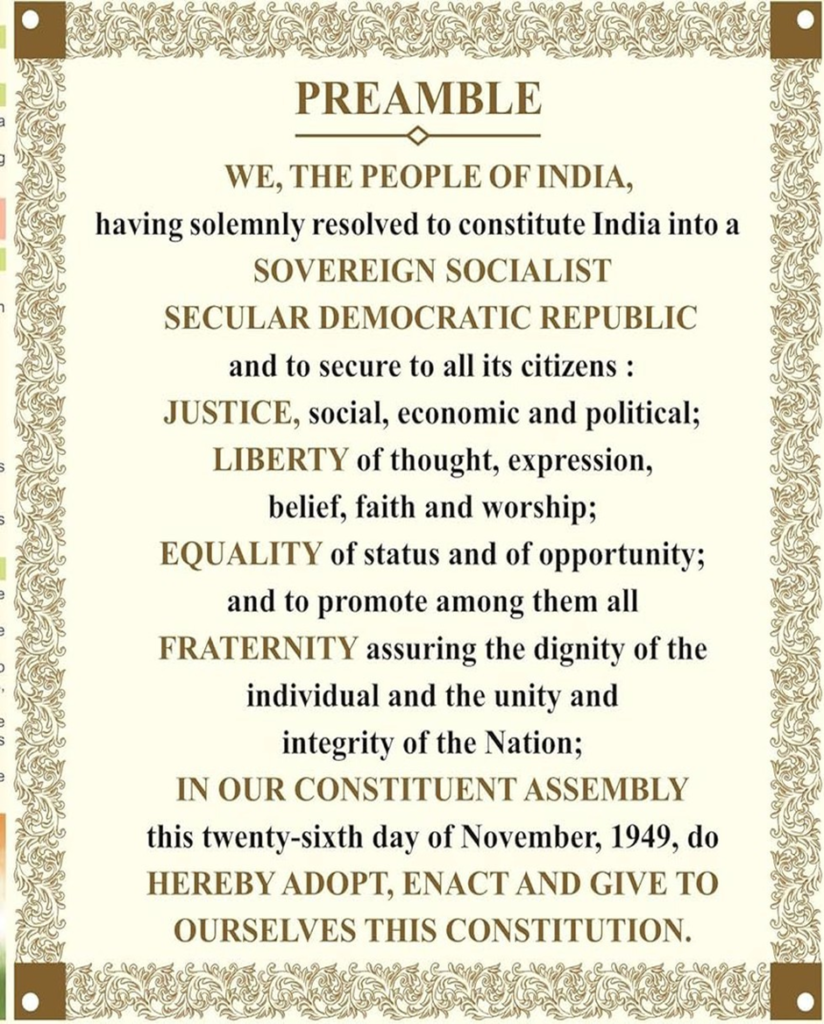
Literal meaning of preamble means the introduction of the constitution. The trend first started by the American constitution then followed by the India.
It is based on the Objective Resolution drafted by the Jawaharlal Nehru and adopted by the constituent assembly.
If we talk about what exactly preamble contains, so it has four components :
- Source of authority: it tells that constitution gets its power from the people of India.
- Nature of Indian state: it declare India as a sovereign, socialist, secular, democratic and republic nation.
- Aspirations of citizen: justice, liberty, equality, fraternity as objective or aspirations of people.
- Date of adoption of constitution: Nov 26, 1949 as adoption date .
There are certain keywords that are highlighted in the document which signifies nature and aspirations of the India, are explained following:
- Sovereign
What exactly being sovereign means that India is neither dependent nor dominion of any other nation. it can take its decision without any external influence.
- Socialist
the term was added through 42nd constitutional amendment in 1976, Indian socialism is a blend of Marxism and Gandhism but heavily leaned toward Gandhian socialism. India has “democratic socialism” brand which support mixed economy i.e. where both public and private sector co-exist hand in hand.
- Secular
It was also added by 42nd CAA of 1976. Indian constitution embodies positive concept of secularism which means there is not national religion ,all the religion have same status and state can support them whenever they need.
- Democratic
A democratic nation is a nation where supreme power are in hands of people.
Democracy is of two types :
- Direct democracy
- Indirect democracy
In direct democracy people excise there power directly eg. In Switzerland. There are four devices of direct democracy ; namely, Referendum,Initiative,Recall,Plebistice.
While in case of indirect democracy peoplr choose there representative ,who on their behalf have power to make decisions. It is also known as Representative democracy and is of two types – parliamentary and presidential. Indian democracy provides parliamentary form of democracy. Where executive is responsible to the legislative for all the policies and decisions.
- Republic
A democratic nation can be classified into two sub-category – monarchy and republic.
In monarch, the head of the state is king or queen and the positions are hereditary in nature but on the other hand in republic nation, the head of the state Is always elected by the people directly or indirectly.
- Justice
The term signifies three forms of justice – social, economical and political which is secured through the fundamental rights and directive principles.
The ideal of justice is been taken from Russian Revolution.
- Liberty
It means the absence of any types of restrictions on activity of people and on the other hand also providing opportunities for personality development of people.
The Preamble signifies the liberty of thought, expression, belief, faith and worship to all the citizen.
The ideal of liberty, equality, fraternity is taken from the French Revolution.
8.Equality
The terms means the absence of any type of special preference to any of section of society.
Preamble provides equality of status and opportunity.
9.Fraternity
It means a sense of brotherhood. The constitution embodies this feeling through the principle of single citizenship.
The word integrity was added to preamble through 42nd CAA 1976.
The phases embodies both psychological as well as territorial dimension of the national integrity.
As mentioned in Article 1 of constitution “union of states” makes it clear that in India no state can secede from union making it an indestructible union.
PREAMBLE:AS A PART OF CONSTITUTION
it has always been in controversies that whether preamble is part of constitution or not. To get answer of this question there has been several cases as discussed below, which will get ourself to the result:
- BERUBARI UNION CASE 1960
In this case supreme court said that preamble is not
Part of the constitution as it just shows the general purpose behind some of the provisions of constitution. and through preamble one can find what makers of constitution exactly thinking that time.
Instead, we can get assistance from preamble at interpretation of constitution.
- KESAVANANDA BHARTI CASE 1973
Here, the SC rejected previous opinion and held that PREAMBLE IS PART OF THE CONSTITUTION.
And said that constitution should be read and interpreted in lights of the grand and noble vision expressed in preamble.
- LIC OF INDIA CASE 1995
PREAMBLE IS AN INTEGRAL PART OF INDIAN CONSTITUION.
Hence the current opinion is that preamble is part of the constitution but we need to remember some of the things that:
- It is non – justiciable which means it cannot be enforced in courts of law.
- It is not a source of power to legislature.
Leave a Reply
You must be logged in to post a comment.